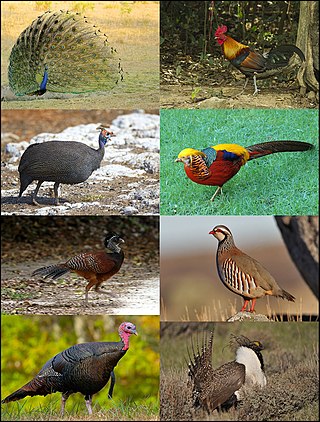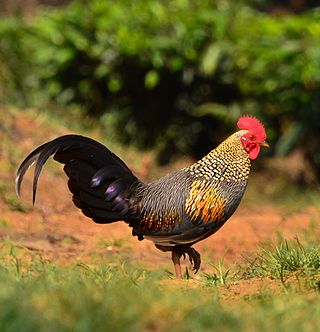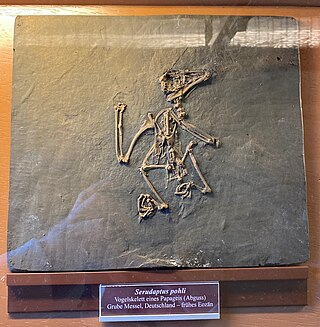
Galliformes is an order of heavy-bodied ground-feeding birds that includes turkeys, chickens, quail, and other landfowl. Gallinaceous birds, as they are called, are important in their ecosystems as seed dispersers and predators, and are often reared by humans for their meat and eggs, or hunted as game birds.

The mousebirds are birds in the order Coliiformes. They are the sister group to the clade Eucavitaves, which includes the Leptosomiformes, Trogoniformes (trogons), Bucerotiformes, Piciformes and Coraciformes. This group is now confined to sub-Saharan Africa, and it is the only bird order confined entirely to that continent, with the possible exception of turacos which are considered by some as the distinct order Musophagiformes, and the cuckoo roller, which is the only member of the order Leptosomiformes, and which is found in Madagascar but not mainland Africa. Mousebirds had a wider range in the Paleogene, with a widespread distribution in Europe and North America during the Paleocene.

Gallinuloides is a prehistoric genus of primitive galliform bird. It lived about 48 million years ago in North America. The type specimen was found in a Green River Formation deposit in Wyoming.
Paleontology or palaeontology is the study of prehistoric life forms on Earth through the examination of plant and animal fossils. This includes the study of body fossils, tracks (ichnites), burrows, cast-off parts, fossilised feces (coprolites), palynomorphs and chemical residues. Because humans have encountered fossils for millennia, paleontology has a long history both before and after becoming formalized as a science. This article records significant discoveries and events related to paleontology that occurred or were published in the year 2003.
Gigantornis eaglesomei is a very large prehistoric bird described from a fragmentary specimen from the Eocene of Nigeria. It was originally described as a representative of the albatross family, Diomedeidae, but was later referred to the pseudotooth or bony-toothed bird family, Pelagornithidae. Gigantornis is one of the largest pseudotooth birds, with an inferred wingspan of about 6 m (20 ft) it is among the largest birds ever.

Pelagornis is a widespread genus of prehistoric pseudotooth birds. These were probably rather close relatives of either pelicans and storks, or waterfowl, and are placed here in the order Odontopterygiformes to account for this uncertainty.

Lithornithidae is an extinct, possibly paraphyletic group of early paleognath birds. They are known from fossils dating to the Upper Paleocene through the Middle Eocene of North America and Europe, with possible Late Cretaceous representatives. All are extinct today; the youngest specimen is the currently unnamed SGPIMH MEV1 specimen from the mid-Eocene Messel Pit site.

Fluvioviridavis is an extinct genus of bird from the Early Eocene Green River Formation of Wyoming. There is only one known species, F. platyrhamphus.

Pangalliformes is the scientific name of a provisional clade of birds within the group Galloanserae. It is defined as all birds more closely related to chickens than to ducks, and includes all modern chickens, turkeys, pheasants, and megapodes, as well as extinct species that do not fall within the crown group Galliformes.
Avolatavis is an extinct genus of stem-parrot (pan-psittaciform) or a member of the stem group of Psittacopasseres, known from the early Eocene Fossil Butte Member of the Green River Formation of Wyoming, United States, and from the London Clay of Walton-on-the-Naze. It was first named by Daniel T. Ksepka and Julia A. Clarke in 2012 and the type species is Avolatavis tenens. Gerald Mayr and Andrew C. Kitchener described the second species, A. europaeus, in 2023. Mayr and Kitchener assigned Avolatavis to the family Vastanavidae, which might be early diverging stem group presentatives of Pan-Psittaciformes or stem group representatives of Psittacopasseres.
The Washakie Formation is a geologic formation in northern Colorado and southern Wyoming. It preserves many mammal, bird, reptile and other fossils dating back to the Lutetian stage of the Eocene within the Paleogene period. The sediments fall in the Bridgerian and Uintan stages of the NALMA classification.

Messelasturidae is an extinct family of birds known from the Eocene of North America and Europe. Their morphology is a mosaic that in some aspects are very similar to modern hawks and falcons, but in others are more similar to parrots. Initially interpreted as stem-owls, more recent studies have suggested a closer relationship to parrots and passerines. Their ecology is enigmatic.
Vastanavidae is an extinct family of birds related to parrots and passerine birds. They are known from fossils from Eocene sites in India, Europe, and North America. The vastanavids resemble parrots and the extinct parrot relative Quercypsitta in their morphology, including the partially zygodactyl foot, in which two toes could face opposite the other two.

Halcyornithidae is an extinct family of telluravian birds thought to be related to the Psittaciformes (parrots), Passeriformes (songbirds), and to the extinct Messelasturidae. Halcyornithids have been found in various Eocene formations in Europe and North America. Widespread and diverse in the Early Eocene of North America and Europe, halcyornithids are not found in locales later than the Middle Eocene. Halcyornithids were small, arboreal birds with zygodactyl feet, with two toes facing forwards and two facing back, a trait shared with other tree-dwelling families of Eocene birds like the Zygodactylidae and the messelasturids. The skull of halcyornithids features a ridge of bone above the eye called the supraorbital process, similar to birds of prey. The relationships of the halcyornithids to other birds remain uncertain. Halcyornithids have been proposed as relatives to owls and as a lineage closer to parrots than to songbirds. Most recently, halcyornithids have been identified as the sister group of the clade including parrots and songbirds. It is also possible that Halcyornithidae is paraphyletic with respect to the Messelasturidae.
Geranoididae is a clade of extinct birds from the early to late Eocene and possibly early Oligocene of North America and Europe. These were mid-sized, long-legged flightless birds. Recent research shows that these birds may actually be palaeognaths related to ostriches.
Morsoravis is an extinct genus of neoavian bird from the Early Eocene Fur Formation of Denmark. It contains a single named species, Morsoravis sedilis. Fossils of Morsoravis have also been found in the Green River Formation of Wyoming and possibly the Nanjemoy Formation of Virginia.
Eocypselus rowei is an extinct bird believed to be ancestral to modern hummingbirds and swifts. It was a small bird, less than 5 in (13 cm) in length, and probably had black feathers. The bird was first described in 2013 and lived approximately 50 million years ago, during the Eocene epoch.
This is an overview of the paleofauna of the Eocene Messel Formation as explored by the Messel Pit excavations in Germany. A former quarry and now UNESCO World Heritage Site, the Messel Formation preserves what once were a series of anoxic lakes surrounded by a sub-tropical rainforest during the Middle Eocene, approximately 47 Ma.
Cyrilavis is an extinct genus of halcyornithid bird from the Early Eocene Fossil Butte Member of the Green River Formation, United States. The genus contains two species, Cyrilavis olsoni and Cyrilavis colburnorum.
Eofringillirostrum is an extinct species of bird known from the Early Eocene Green River Formation of the Western United States and from the Messel Pit in Germany. The genus contains two species, Eofringillirostrum boudreauxi and Eofringillirostrum parvulum. They are the earliest known fossil birds to have a finch-like beak.











